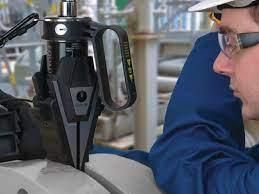Flange spreaders are tools used for separating pipe flanges. These tools are designed to helpdisassemble and reassemble pipe flanges safely and quickly. They are usually constructed fromsteel and come in various shapes and sizes depending on the type of flange being worked on.Some flange spreaders are designed to be used by hand, while others are powerful tools thatcan be used with a drill.
Using flange spreaders to separate pipe flanges to make repairs or to install new flanges. It isimportant that the flanges are separated properly to ensure a tight seal when the flanges arereassembled. Improperly separated flanges can cause leaks, which can lead to dangeroussituations.It is also used to loosen bolts that have been tightened too much or have corroded due to age.This is done by inserting the spreader between the flanges and gently pushing them apart. Thebolts can then be loosened without damaging the flanges.It is designed to be used with various types of flanges, including flat-face flanges, raised-faceflanges, and joint ring flanges. They come in various sizes and shapes; some can work onmultiple flange types.There is an essential tool in many industries, and using these tools can help prevent accidentsand ensure that repairs and installations are done safely and correctly. They are a cost-effectivesolution to many flange-related problems and can help reduce the amount of time it takes tocomplete a job.
How do Flange Spreaders work?
Flange spreaders are tools used to separate two flange faces with a controlled amount of force.They are designed to provide an even and consistent force to create a uniform gap between thetwo flange faces. Flange spreaders are often used in industrial applications where two flangesmust be separated with a precise gap size.It consists of two main parts, the spreader body and the spreader arms. The spreader body ismade of durable steel or aluminum and typically has a handle or wheel that allows it to beadjusted or tightened. The spreader arms are attached to the spreader body and can beadjusted for various sizes of flanges. The spreader arms are also typically made of a durablematerial such as steel or aluminum.
When a flange spreader is used, the user must first determine the size of the gap that needs tobe created between the two flanges. The spreader arms are then adjusted to the appropriatesize and the spreader body is tightened until the desired gap is achieved. Once the gap isachieved, the spreader arms can be released and the flange faces can be moved apart.The flange spreaders are designed to provide even and consistent force to the two flange facesand are often used in applications such as pipe fittings, tank flanges, and boiler flanges. Theyare also commonly used to separate two flanges that have been joined together by welding.Using a flange spreader helps ensure that the two flanges are evenly separated and that theweld is not compromised. TorcStarkis a great place to buy different types of Flange Spreaders.It is an essential tool for any industrial application where two flanges must be separated with aprecise gap size. They offer an even and consistent force to the two flanges and can be used toseparate two flanges that have been joined together by welding. Flange spreaders are a reliableand efficient way to open and close flanges precisely.
What Are The Benefits Of Using Flange Spreaders?Flange spreaders are used to open up flanges or pipe joints in order to make repairs andmodifications. They are an essential tool for many industrial and engineering jobs. The mainbenefit of using flange spreaders is that they are a safe and efficient way to separate flanges orpipe joints without using traditional methods such as hammers and chisels. Flange spreadersare designed to evenly and gently spread apart the two pieces that make up a flange or pipejoint, which helps to minimize the risk of damage or injury.Additionally, flange spreaders are typically easy to use and require less physical effort thantraditional methods, making them a more convenient option. Furthermore, they can be used tospread apart flanges and joints of varying sizes and shapes, making them a very versatile tool.



 Christmas and New Year gift card
Photo by
Christmas and New Year gift card
Photo by  butter cookies on plate
Photo by
butter cookies on plate
Photo by  boy holding Holy
boy holding Holy 








